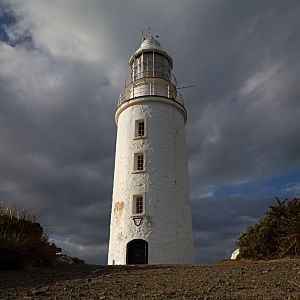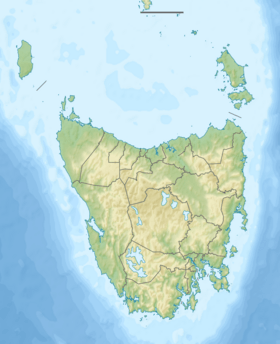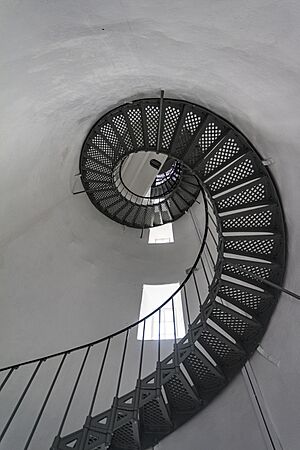Cape Bruny Lighthouse facts for kids
 |
|
| Cape Bruny Lighthouse in 2015 | |
|
|
|
| Location | Bruny Island Tasmania Australia |
|---|---|
| Coordinates | 43°29′28.1″S 147°08′32.0″E / 43.491139°S 147.142222°E |
| Year first constructed | 1838 (first) |
| Year first lit | 1996 (current) |
| Automated | 1996 |
| Deactivated | 1996 (first) |
| Construction | rubble masonry tower (first) fiberglass tower (current) |
| Tower shape | conical tower with double balcony and lantern (first) |
| Markings / pattern | white tower and lantern |
| Height | 13 metres (43 ft) (first) 5 metres (16 ft) (current) |
| Focal height | 93 metres (305 ft) (first) 105 metres (344 ft) (current) |
| Intensity | 1,400,000 cd (current) |
| Range | 26 nautical miles (48 km; 30 mi) (current) |
| Characteristic | Fl W 10s. (current) |
| Admiralty number | K3654 |
| NGA number | 6868 |
| ARLHS number | AUS-024 |
The Cape Bruny Lighthouse is an old lighthouse located at the very end of Bruny Island in Tasmania, Australia. It is no longer used as the main light. This lighthouse is special because it is the second oldest lighthouse tower still standing in Australia. It also holds the record for being continuously staffed by people for the longest time, 158 years!
History of the Lighthouse
The lighthouse was first lit in March 1838. It was finally turned off on August 6, 1996. The idea for the lighthouse came from Governor George Arthur in 1835. This was after many ships crashed south of Bruny Island.
Building the lighthouse started in April 1836. It was built by convict labourers, who were people sent to Australia as punishment. They used strong local stone called dolerite. It took two years to build. When it was finished in 1838, it was Tasmania's third lighthouse and Australia's fourth.
The first light in Cape Bruny Lighthouse used a special lamp called a Wilkins lantern. This lamp burned oil from sperm whales. In 1892, they switched to a better type of oil. In 1903, the old wooden staircase was replaced with a strong cast-iron one. The Wilkins lantern was also replaced with a new Chance Brothers lantern. Both the new staircase and lantern are still in the tower today.
Cape Bruny Today
In December 2000, the lighthouse area became part of the South Bruny National Park. For a long time, a permanent caretaker looked after the lighthouse. Since 2011, volunteers now help maintain the site. These volunteers live in the caretaker's cottage for about four weeks at a time. They help with repairs and general upkeep.
You can visit the Cape Bruny Lighthouse today. Some companies offer tours inside the lighthouse tower. There is also a newer, smaller light tower nearby. This modern light is made of fiberglass and is about 4 meters tall. It flashes a white light every 10 seconds. This light helps guide ships even now.



